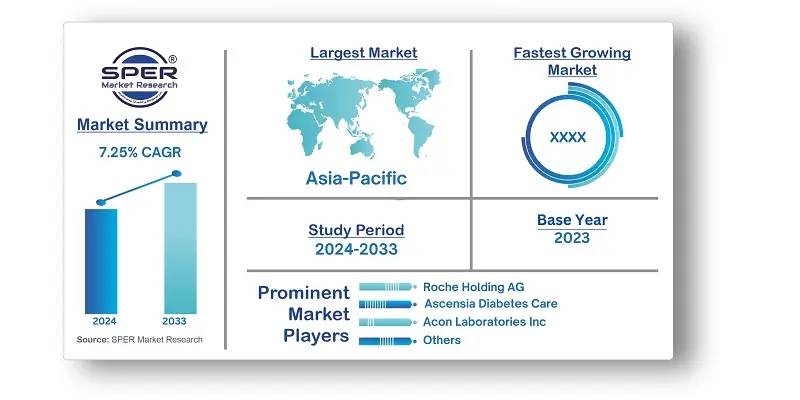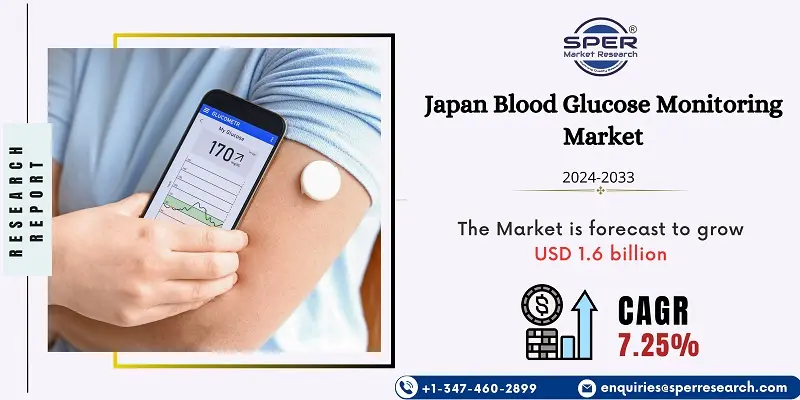
Japan Blood Glucose Monitoring Market Trends, Share, Size, Demand, Revenue and Future Outlook
Japan Blood Glucose Monitoring Market Growth, Size, Trends Analysis- By Type, By Component- Regional Outlook, Competitive Strategies and Segment Forecast to 2033
| Published: Nov-2024 | Report ID: MEDE2448 | Pages: 1 - 101 | Formats*: |
| Category : Medical Devices | |||
- In June 2023, Kakao Healthcare plans to launch a Dexcom-powered diabetes management program. This partnership makes use of Dexcom's cutting-edge continuous glucose monitoring (CGM) devices, specifically the Dexcom G6 and G7, as well as Kakao Healthcare's proficiency in AI and software technologies. It is important to note that Dexcom is presently working to get the Ministry of Food and Drug Safety to approve these devices.
- In May 2022, Terumo declares that the Dexcom G6 CGM System's indication has been modified in Japan. With the addition of this additional indication, the Dexcom G6 CGM System will be the only one available in Japan that can be used primarily for managing blood glucose levels on a daily basis without the need for a blood glucose meter.


| Report Metric | Details |
| Market size available for years | 2020-2033 |
| Base year considered | 2023 |
| Forecast period | 2024-2033 |
| Segments covered | By Type, By Component |
| Regions covered | Kanto Region, Kniki Region, Central/Chubu Region, Kyushu-Okinawa Region, Chugoku Region Shikoku Region |
| Companies Covered | Abbott Diabetes Care, Roche Holding AG, LifeScan, Dexcom Inc, Medtronic PLC, Arkray Inc, Ascensia Diabetes Care, Agamatrix Inc, Bionime Corporation, Acon Laboratories Inc. |
- Diabetes Patients
- Hospitals and Clinics
- Healthcare Professionals (Endocrinologists, Diabetologists)
- Home Care Providers
- Pharmacies and Retailers
- Diabetes Management Centers
- Medical Device Manufacturers and Distributors
- Government and Regulatory Bodies
- Insurance Companies
| By Type: | |
| By Component: | |
| By Region: |
- Japan Blood Glucose Monitoring Market Size (FY’2024-FY’2033)
- Overview of Japan Blood Glucose Monitoring Market
- Segmentation of Japan Blood Glucose Monitoring Market By Type (Self-Monitoring Blood Glucose, And Continuous Glucose Monitoring)
- Segmentation of Japan Blood Glucose Monitoring Market By Component (Glucometer Devices, Test Strips, Lancets, Sensors, And Durables)
- Statistical Snap of Japan Blood Glucose Monitoring Market
- Expansion Analysis of Japan Blood Glucose Monitoring Market
- Problems and Obstacles in Japan Blood Glucose Monitoring Market
- Competitive Landscape in the Japan Blood Glucose Monitoring Market
- Impact of COVID-19 and Demonetization on Japan Blood Glucose Monitoring Market
- Details on Current Investment in Japan Blood Glucose Monitoring Market
- Competitive Analysis of Japan Blood Glucose Monitoring Market
- Prominent Players in the Japan Blood Glucose Monitoring Market
- SWOT Analysis of Japan Blood Glucose Monitoring Market
- Japan Blood Glucose Monitoring Market Future Outlook and Projections (FY’2024-FY’2033)
- Recommendations from Analyst
1.1. Scope of the report1.2. Market segment analysis
2.1. Research data source
2.1.1. Secondary Data2.1.2. Primary Data2.1.3. SPER’s internal database2.1.4. Premium insight from KOL’s
2.2. Market size estimation
2.2.1. Top-down and Bottom-up approach
2.3. Data triangulation
4.1. Driver, Restraint, Opportunity and Challenges analysis
4.1.1. Drivers4.1.2. Restraints4.1.3. Opportunities4.1.4. Challenges
4.2. COVID-19 Impacts of the Japan Blood Glucose Monitoring Market
5.1. SWOT Analysis
5.1.1. Strengths5.1.2. Weaknesses5.1.3. Opportunities5.1.4. Threats
5.2. PESTEL Analysis
5.2.1. Political Landscape5.2.2. Economic Landscape5.2.3. Social Landscape5.2.4. Technological Landscape5.2.5. Environmental Landscape5.2.6. Legal Landscape
5.3. PORTER’s Five Forces
5.3.1. Bargaining power of suppliers5.3.2. Bargaining power of buyers5.3.3. Threat of Substitute5.3.4. Threat of new entrant5.3.5. Competitive rivalry
5.4. Heat Map Analysis
6.1. Japan Blood Glucose Monitoring Market Manufacturing Base Distribution, Sales Area, Product Type6.2. Mergers & Acquisitions, Partnerships, Product Launch, and Collaboration in Japan Blood Glucose Monitoring Market
7.1. Japan Blood Glucose Monitoring Market Size, Share and Forecast, By Type, 2020-20267.2. Japan Blood Glucose Monitoring Market Size, Share and Forecast, By Type, 2027-20337.3. Self-Monitoring Blood Glucose7.4. Continuous Glucose Monitoring
8.1. Japan Blood Glucose Monitoring Market Size, Share and Forecast, By Component, 2020-20268.2. Japan Blood Glucose Monitoring Market Size, Share and Forecast, By Component, 2027-20338.3. Glucometer Devices8.4. Test Strips8.5. Lancets8.6. Sensors8.7. Durables
9.1. Japan Blood Glucose Monitoring Market Size and Market Share
10.1. Japan Blood Glucose Monitoring Market Size and Market Share By Region (2020-2026)10.2. Japan Blood Glucose Monitoring Market Size and Market Share By Region (2027-2033)10.3. Kanto Region10.4. Kinki Region10.5. Central/ Chubu Region10.6. Kyushu-Okinawa Region10.7. Chugoku Region10.8. Shikoku Region
11.1. Abbott Diabetes Care
11.1.1. Company details11.1.2. Financial outlook11.1.3. Product summary11.1.4. Recent developments
11.2. Roche Holding AG
11.2.1. Company details11.2.2. Financial outlook11.2.3. Product summary11.2.4. Recent developments
11.3. LifeScan
11.3.1. Company details11.3.2. Financial outlook11.3.3. Product summary11.3.4. Recent developments
11.4. Dexcom Inc
11.4.1. Company details11.4.2. Financial outlook11.4.3. Product summary11.4.4. Recent developments
11.5. Medtronic PLC
11.5.1. Company details11.5.2. Financial outlook11.5.3. Product summary11.5.4. Recent developments
11.6. Arkray Inc
11.6.1. Company details11.6.2. Financial outlook11.6.3. Product summary11.6.4. Recent developments
11.7. Ascensia Diabetes Care
11.7.1. Company details11.7.2. Financial outlook11.7.3. Product summary11.7.4. Recent developments
11.8. Agamatrix Inc
11.8.1. Company details11.8.2. Financial outlook11.8.3. Product summary11.8.4. Recent developments
11.9. Bionime Corporation
11.9.1. Company details11.9.2. Financial outlook11.9.3. Product summary11.9.4. Recent developments
11.10. Acon Laboratories Inc
11.10.1. Company details11.10.2. Financial outlook11.10.3. Product summary11.10.4. Recent developments
11.11. Others
SPER Market Research’s methodology uses great emphasis on primary research to ensure that the market intelligence insights are up to date, reliable and accurate. Primary interviews are done with players involved in each phase of a supply chain to analyze the market forecasting. The secondary research method is used to help you fully understand how the future markets and the spending patterns look likes.
The report is based on in-depth qualitative and quantitative analysis of the Product Market. The quantitative analysis involves the application of various projection and sampling techniques. The qualitative analysis involves primary interviews, surveys, and vendor briefings. The data gathered as a result of these processes are validated through experts opinion. Our research methodology entails an ideal mixture of primary and secondary initiatives.



Frequently Asked Questions About This Report
PLACE AN ORDER
Year End Discount
Sample Report
Pre-Purchase Inquiry
NEED CUSTOMIZATION?
Request CustomizationCALL OR EMAIL US
100% Secure Payment






Related Reports
Our Global Clients
Our data-driven insights have influenced the strategy of 200+ reputed companies across the globe.




















